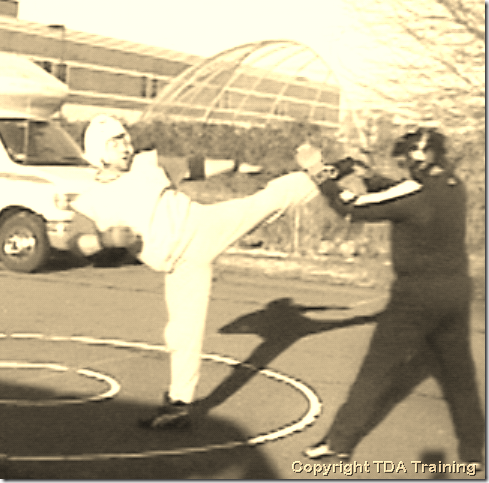
Our post, Repost: Why do we get hit, has prompted a complimentary post by MarksTraining.com, Guarding When Kicking. He raises some very good points.
A lot of times when people throw kicks, there arms suddenly drop down, allowing for a successful counter to be made from the opponent which could result in a knockout. Against a beginner you may be able to get away with it, but an advanced fighter will see this flaw in your game and shall eventually start using it against you.
Although the arms are used to create momentum for a more powerful kick the option is always there to leave at least one hand high covering the face area, defending any counter.
He's right, of course. You do need to counterbalance kicks, especially high ones, but every time you're on one leg, you eliminate the possibility of slipping or evading counterstrikes or takedown attempts. Your only protection has to be your guard position.
For further examples of this, check out Video: Kicks versus Punches handicap, and another at Todays TDA Tip: Handicap Sparring Key to Improvement.

3 comments:
Most people use some upper body movement to initiate kicks. Kicks that require a lot of upper body motion are swinging type kicks, head-high kicks, and long-range kicks. These are mostly the kicks that are to land in the upper range of the kicker's ability.
There are kicks however that can be performed with minimal upper body involvement. These are short range basic kicks, stomps, foot scrapes, and perhaps knees.
Reaching from one extreme to another, you get to choose how much you give up and telegraph, versus the length or height or showiness of the kick.
It's really a good idea to get a feel of how far or high you can kick without telegraphing it too much! This means the coverage or guard remains up, and you are really using a lot of hip and leg muscle with no upper body involvement.
Check out Training Aids that Wreck Combat Technique
Colin
Colin,
Brilliant reply to this post. The lower the kick, the less telegraphing, and elmost any type of front-style kick doesn't telegraph or require a body lean/guard drop.
The one disadvantage to those types of kicks are the opening that a front/square facing can create. In other words, every type of technique is a compromise of offense and defense, and you have to pick the ones that, for your body type and ability, will yield the highest percentage chance of success.
Thanks for the comment.
This post is being revived, so I'd like to point out that the definition of the success you mentioned needs to be scrutinized. Many people have no idea how to consistently knock a person out or knock the wind out of a person with a kick. Many times kicks are exchanged in the hope that distance will be kept, and a nice 'force feedback' is felt to justify the kick being thrown out in sparring. Mostly those kicks are thrown haphazardly, and will result in a low kick/hit ratio. My advice is to make sure a lot of time is spent in front of the mirror to ensure that kicks are subtle and are fired in such a way as to disguise the original movement. Keeping contact light allows you to increase the speed of kicks and to learn how to use your lower limbs as well as your arms. Once you build up strength in hip, back, and torso muscles, the upper body involvement may decrease, and you'll be able to fire kicks off that could be the equivalent of jabs. Or if you have the chance, you juice it up and power through the opponent.
See How to do a high roundhouse kick
Post a Comment